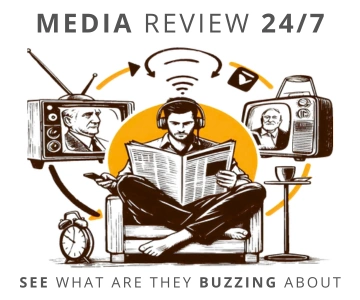 illustration: DALL-E
illustration: DALL-EWeb users shift from classic social networks to video platforms. Nic Newman and the Reuters Institute team state this in the latest "Digital News Report 2025". Facebook still leads for news reach, edging past YouTube. Yet TikTok grabs momentum fastest. In Thailand, almost half of respondents (49%) now follow news there. That figure is up ten points in a year.
In practice, this signals the rapid ageing of traditional text formats. Publishers that once banked on long reads must now serve vertical video, short clips and live streams to hold the eye. Newsrooms in Mexico and the Philippines already reshuffle teams and schedules because the TikTok algorithm rewards frequency.
- 36% use Facebook for news
- 30% choose YouTube for the same purpose
- 16% worldwide take news from TikTok
The rise of short forms sparks a battle for seconds of focus. The viewer scans the screen for a headline that grabs in the first two sentences. Journalists adapt, recording punchy intros that give the number, location and main actor at once. Nic Newman’s analysis shows that average watch time for news shorts rose by 27% year on year.
See video: 7 facts about news on social media
Influencers. New newsroom old problem
Newsrooms once chose the front-page topics. Now online creators come first. In the United States, 22% said they listened to Joe Rogan in the week after the president’s inauguration. In France, Hugo Travers ("HugoDécrypte") draws the same share of viewers under 35. Popularity brings power. Audiences say that influencers rival big networks in shaping debate.
| Creator / Country | Weekly reach | Main platform |
|---|---|---|
| Joe Rogan / USA | 22% online viewers | Podcast + YouTube |
| Hugo Travers / France | 22% viewers < 35 yrs | YouTube + TikTok |
| Gustavo Gayer / Brazil | 1.9 m subscriptions | YouTube |
| Dhruv Rathee / India | 19 m subscriptions | YouTube |
| BeerBiceps / India | 6.5 m subscriptions | YouTube |
Respondents also name online creators as the top potential source of misinformation. As many as 47% see them as the main threat alongside politicians. Experts note that an influencer enjoys a ‘parasocial’ bond with viewers. They talk directly, answer comments and the algorithm pushes the video to like-minded users. The result is content that skips the old newsroom filter and fact-checking.
Newsrooms respond by inviting star creators to debates or asking them to cross-post verified content. The British BBC runs a TikTok duet series where a journalist answers an influencer’s comments, correcting rumours. "Le Monde" recruited famous economic YouTubers to explain inflation in an ‘explain like I’m five’ style. The report’s authors say such alliances can limit the reach of false stories if both sides stay clear about sources.
Video format takes over news
Video is not only growing. It already dominates. The share of social video in news use jumped from 52% in 2020 to 65% in 2025. In the United States, weekly viewing of video news rose from 55% to 72% in just four years. Most of that use, 61%, happens on social platforms rather than publisher sites.
- 52% → 65% social video share in 2020-2025
- 55% → 72% Americans watch video news weekly
- 61% viewers pick platforms, 29% publisher sites
- 67% → 75% growth in any video news viewing worldwide
Data show that text is fast losing its edge even in reading-strong nations such as Germany or the United Kingdom. Younger audiences would rather swipe a screen than scan columns. "Digital News Report 2025" advises newsrooms to move budget from page layout to editing. It also urges them to place vertical video on their own sites.
The "New York Times" shows the payoff. Adding a vertical video carousel on the home page raised average time on site by 18%, and paywall clicks held steady. "The Economist" saw a similar effect after placing thirty second reporter clips above classic leads. Nic Newman notes that viewers love short form yet still return for depth when a video signals the scale of an issue.
Digital News Report 2025 was produced through cooperation between the Reuters Institute for the Study of Journalism and YouGov. The survey covered 94 943 internet users in 47 countries, interviewed online in January to February 2025. Results were weighted to reflect the online population in each country. The full report is free on the Reuters Institute site.
COMMERCIAL BREAK
New articles in section Media industry
Advertising market 2025. Poland, Europe and the World
Marcin Grządka
The global advertising market is growing by 8.8% in 2025 and will reach a value of 1.14 trillion dollars. The industry result in Europe records slightly lower dynamics, at the level of 5.8%. In this comparison, Poland performs clearly above the average. We will record an increase of 8.9% this year and a value of 18.56 billion PLN - estimates WPP Media in the annual report "This Year Next Year".
The print media market 2025. Three global trends
Krzysztof Fiedorek
The market value is 359.53 billion dollars, yet the erosion is visible to the naked eye. The decline for newspapers will amount to -2.3 percent. Despite this, print retains strength: it generates 76 percent of subscription revenues and enjoys 82 percent consumer trust. The future of the industry is defined by hybrid strategies and niche specialization.
Journalism in the age of AI. Why people prefer humans over machines
Krzysztof Fiedorek
Only 12% of people accept news created solely by AI, while 62% prefer those written by humans. At the same time, only 19% notice labels indicating the use of artificial intelligence, while younger audiences ask AI to explain the content to them. These are the findings of the Reuters Institute report on artificial intelligence in media.
See articles on a similar topic:
Digital Newspapers in Poland
Bartłomiej Dwornik
The three largest distributors of digital press editions in Poland sell around 270,000 e-magazine copies monthly, according to Money.pl analysis. Digital press is mostly read by experienced internet users, managers, and emigrants.
Global Media Under Scrutiny. Reuters Institute Digital News Report 2024
Krzysztof Fiedorek
The “Digital News Report 2024,” developed by the Reuters Institute for the Study of Journalism, describes the landscape of digital news media based on data from 47 markets, representing more than half of the world’s population.
How Journalists Use Social Media
Bartłomiej Dwornik
Primarily, they seek inspiration from blogs and, less frequently, from Facebook. They rarely trust what they find, often approaching it with caution. Credibility does not necessarily correlate with attractiveness.
The Future of Journalism and Media. Predictions by Reuters Institute
KFi
74% of publishers fear a decline in search traffic. Paid subscribers are no longer growing as they used to, and relationships with tech giants are becoming increasingly complex. The report "Journalism, Media, and Technology Trends and Predictions 2025" forecasts what lies ahead for the media world in 2025.





























